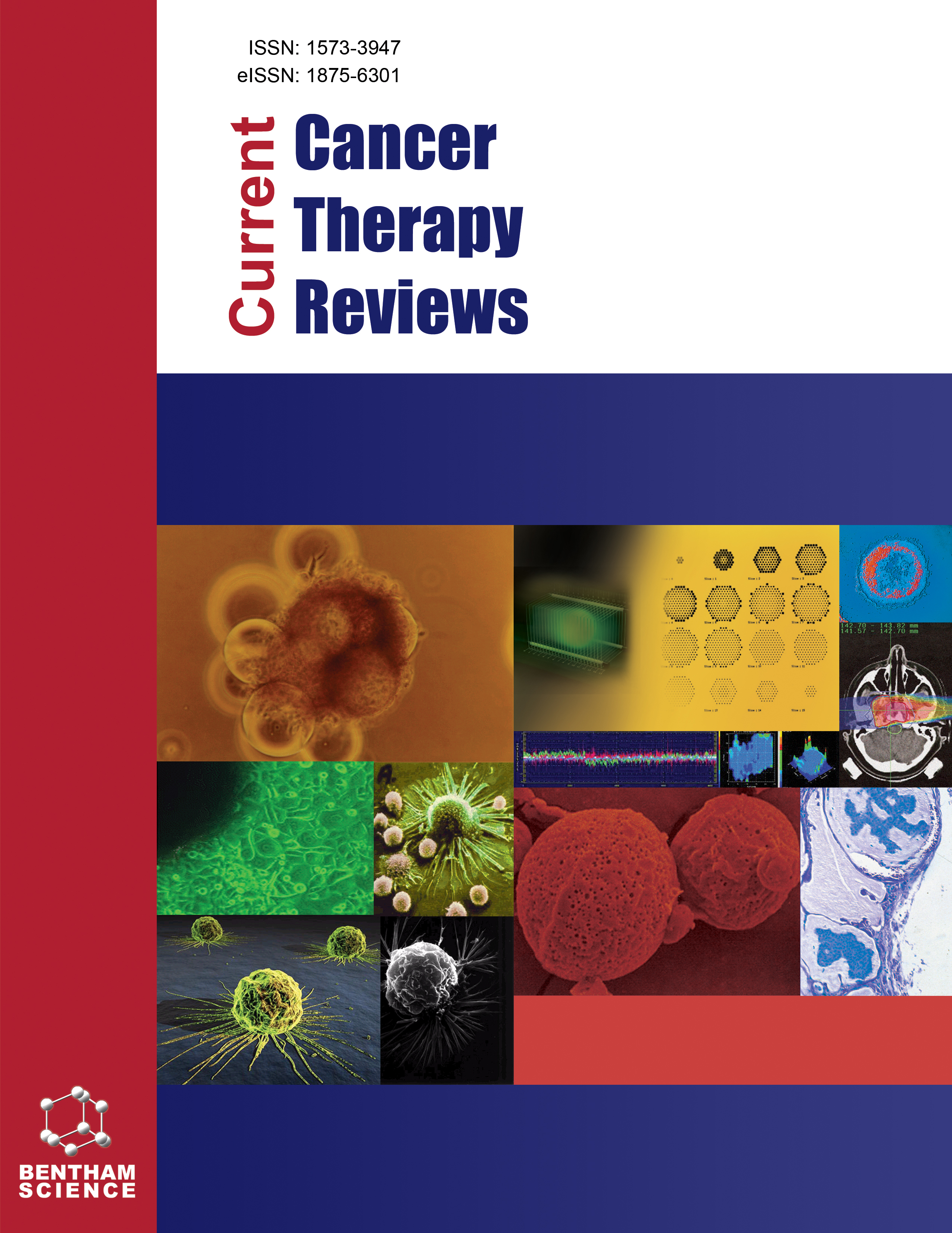- Home
- A-Z Publications
- Current Cancer Therapy Reviews
- Previous Issues
- Volume 6, Issue 2, 2010
Current Cancer Therapy Reviews - Volume 6, Issue 2, 2010
Volume 6, Issue 2, 2010
-
-
HPV and Therapeutic Vaccines: Where are We in 2010?
More LessAuthors: Barbara Ma, Yijie Xu, Chien-Fu Hung and T.-C. WuThe discovery of human papillomavirus (HPV) as a necessary etiological factor for cervical cancer has spurred the development of preventive and therapeutic HPV vaccines for the control of HPV-associated malignancies including cervical, vulvar, vaginal, and a subset of head and neck cancers. The commercial preventive HPV vaccines, Gardasil and Cervarix, use HPV virus-like particles to generate neutralizing antibodies against Read More
-
-
-
HPV Screening: Available Data and Recommendations for Clinical Practice
More LessAuthors: Guglielmo Ronco and Chris J.L.M. MeijerCervical screening based on testing for the DNA of high-risk HPV types as primary screening test detects the precursors of cervical cancers earlier than cytology. This allows longer screening intervals and results in increased effectiveness in preventing invasive cervical cancers. Data suggest that protection is similar irrespective whether sole HPV testing or HPV in conjunction with cytology are applied as primary tests. In additi Read More
-
-
-
From HPV Infection to Oncogenesis: A Brief Review of the Complex Immunobiological Events
More LessAuthors: Peter L. Stern and Mark H. EinsteinThis article reviews the natural history of HPV infection covering key aspects of cell biology, virology and immunology. The oncogenic HPV lifecycle is characterised by infection in basal cells of anogenital epithelia with virus production dependent on epithelial differentiation and virions produced only in terminally differentiated cells. Natural control of an oncogenic type HPV infection depends on appropriate activation of innate im Read More
-
-
-
The Discovery of HPV and its Clinical Implications
More LessAbout 35 years ago human papillomaviruses (HPV) have been suggested as causative agent for cervical cancer whose infectious etiology had been suggested already many years before. The discovery of the plurality of HPVs encompassing a variety of types with particular biologic properties, the regular presence of the genomes of the so called high-risk types within tumor biopsies, the awareness about the transforming poten Read More
-
-
-
HPV Vaccination in Women Above 25 Years: Reasons Why?
More LessAuthors: W. Poppe, PH. Simon, W. Tjalma and M. De RidderProphyllactic HPV vaccines are efficacious in preventing persistent infections by vaccine-HPV types and related cervical disease. The maximum effect is achieved in women who are not exposed to HPV vaccine types at the time of vaccination (HPV DNA negative women). Today's published data demonstrate equal clinical vaccine efficacy in women between 15 and 26 years and women between 24 and 45 years. The public h Read More
-
-
-
Innate Immunity and Vaccine Adjuvants: From Concepts to the Development of a Unique Adjuvant System AS04 Used for the Formulation of a Human Papillomavirus (HPV) Vaccine
More LessAuthors: Nathalie Garcon and Oberdan LeoNew vaccine technology has led to vaccines containing highly purified antigens with improved safety profiles, but increased antigen purity often results in weakened immunogenicity. A better understanding of innate and adaptive immunity and their interaction at the molecular level has led to the use of innovative adjuvants combined with careful antigen selection. Adjuvants can be used to amplify the immune response, and th Read More
-
-
-
HPV Vaccination in Adolescents: From Clinical Data to Implementation and Practice
More LessAuthors: Franco Borruto and Karel HoppenbrouwersPersistent human Papillomavirus (HPV) infections are now recognised as the leading cause of cervical cancer (CC). Approximately 100 types of human infecting HPV exist in nature and according to the samples collected from either pre-cancerous or cancerous lesions, almost ten are responsible for a good part of the CC cases. Two anti-HPV vaccines are currently registered worldwide - a tetravalent and a bivalent one Read More
-
-
-
Chemoprevention of Colorectal Cancer: Progress or Pipedream?
More LessAuthors: Rutger J. Jacobs, Liudmila L. Kodach and James C.H. HardwickColorectal cancer is a leading cause of death by cancer in the western world. Present oncological treatments have relatively little impact on long term survival and hope is pinned on screening. Current population-based screening methods are insufficient in reducing colorectal cancer deaths, therefore new approaches are needed. One approach is chemoprevention, which targets specific signalling pathways to interfere in the Read More
-
-
-
MicroRNAs in Cancer Therapy: From Bench to Bedside
More LessAuthors: Srikumar Sengupta and Anupam BishayeeMicroRNAs (miRNAs) are short (∼22 nucleotides), highly conserved non-coding RNA molecules that bind to sequences in the 3' untranslated region (3' UTR) of genes with full or partial complementarity, leading to their degradation and/or translational inhibition. Dysregulation of miRNA expression is associated with several human cancers and accumulation of these molecules differs significantly between normal and neo Read More
-
-
-
Therapeutic Cancer Vaccines
More LessAuthors: Stine Kiaer Larsen, Inge Marie Svane, Per thor Straten and Mads Hald AndersenThe use of cancer vaccines to induce anti-tumor immune responses holds huge potential to complement traditional cancer therapies. Cancer vaccines are designed to re-calibrate the existing host-tumour interaction, tipping the balance from tumor acceptance towards tumor control to the benefit of the cancer patient. Additionally, the highly specific character of the host immune response minimizes the risk for unattractive Read More
-
Volumes & issues
-
Volume 21 (2025)
-
Volume 20 (2024)
-
Volume 19 (2023)
-
Volume 18 (2022)
-
Volume 17 (2021)
-
Volume 16 (2020)
-
Volume 15 (2019)
-
Volume 14 (2018)
-
Volume 13 (2017)
-
Volume 12 (2016)
-
Volume 11 (2015)
-
Volume 10 (2014)
-
Volume 9 (2013)
-
Volume 8 (2012)
-
Volume 7 (2011)
-
Volume 6 (2010)
-
Volume 5 (2009)
-
Volume 4 (2008)
-
Volume 3 (2007)
-
Volume 2 (2006)
-
Volume 1 (2005)
Most Read This Month
Article
content/journals/cctr
Journal
10
5
false
en


